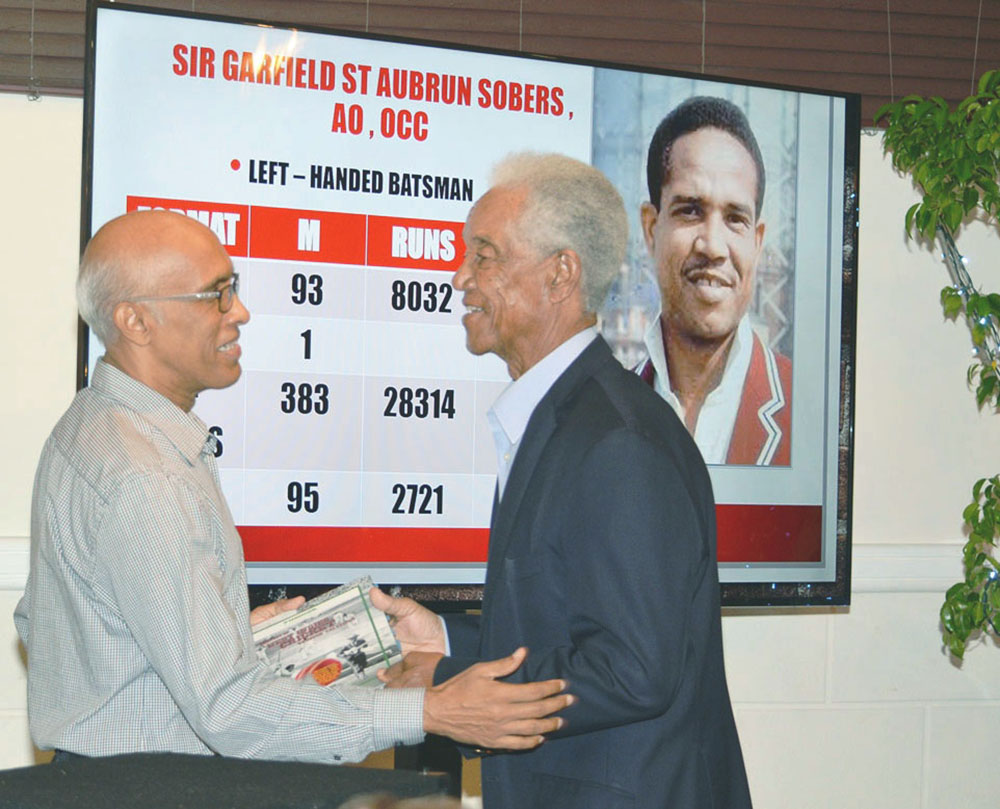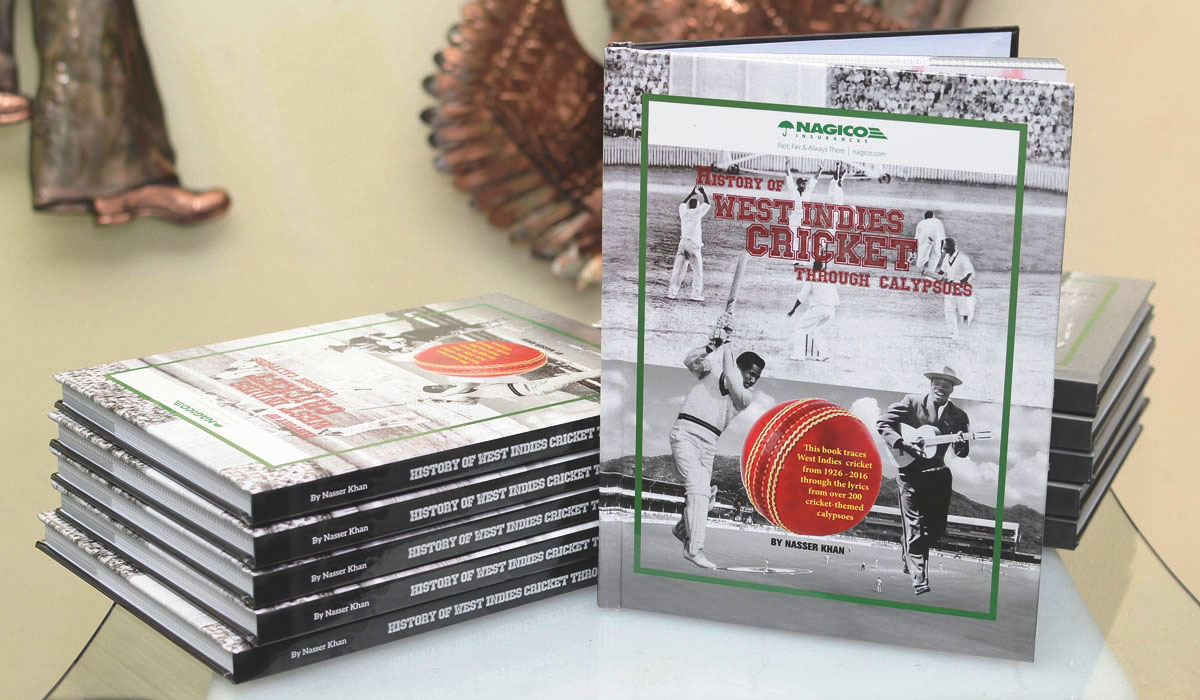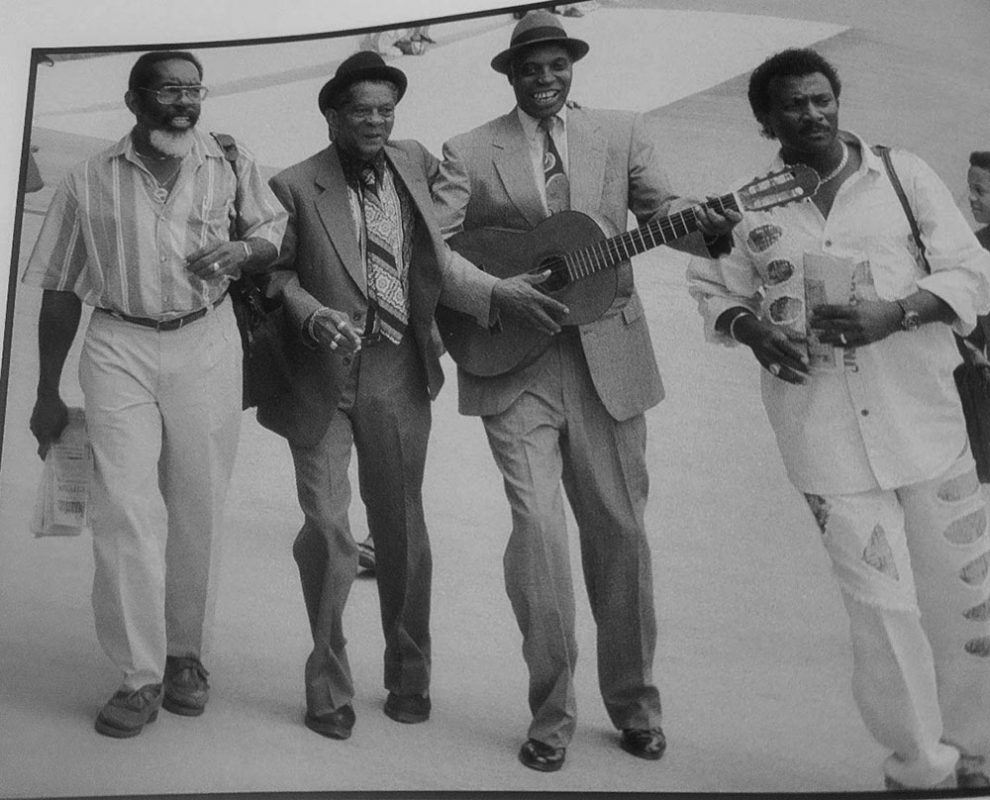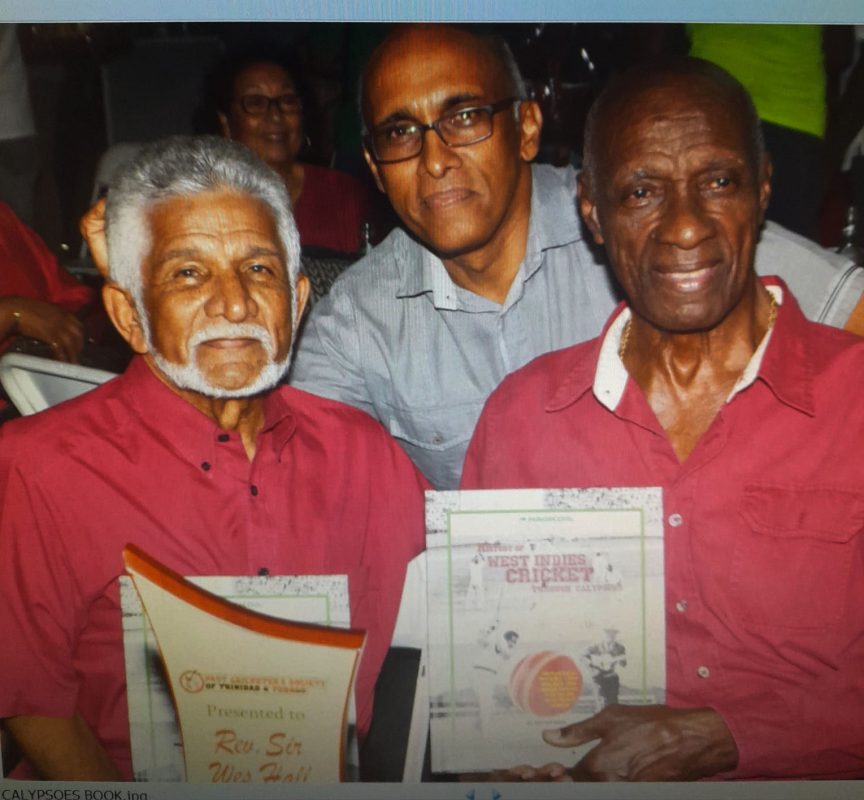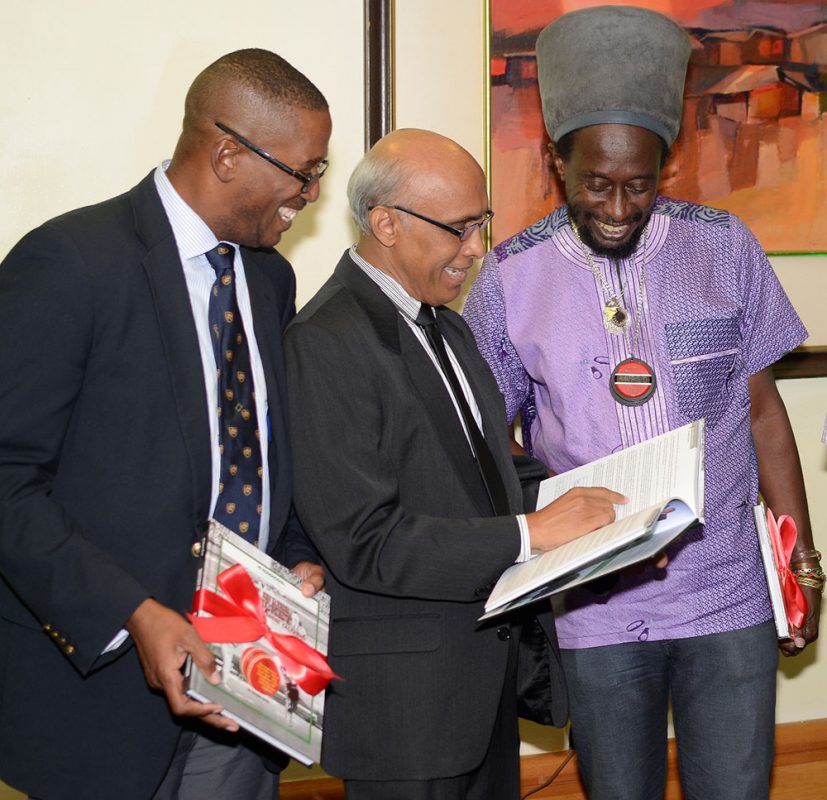“Calypsoes sung at Lord’s,” screamed the headlines of England’s Daily Telegraph and Morning Post newspapers on 30th June, 1950, the day after the West Indies had beaten England by 326 runs in the Second Test at Lord’s to level the series at 1 – 1. Unwittingly, it was the international stage debut of the symbiotic relationship between the two art forms which can be traced back as far as 1926. Over time they have become intricately interwoven like the complex patterns of a Carib hammock.
The two interchangeable phrases ‘Calypso cricketers’ and ‘Calypso cricket’ have become so associated with the Caribbean game that casual observers probably assume they are the team’s official copyrighted slogans. The terms stir the imagination, creating an inseparable amalgam of colour, sound, rhythm and light. Oodles of energy! Laughter! Fun! Excitement. Fast bowlers! Sixes! Fours! Lots of Singing! Wild Celebrations!
In the ensuing years as the West Indies rose to become unofficial ‘world champions’ in the 1960s, one-day champions in the 1970s, then embarked on their unprecedented streak of world dominance in 1980s and early 1990s, and all through the woes of this century, West Indian calypsonians were capturing for posterity, both on and off the field performances – good and bad – with a slew of recordings. Caribbean cricket fans will vehemently debate the merits and strengths of cricket calypsoes with the same intensity as if they were comparing the stats of their favourite cricketers.
Over the years, keen followers of the game have lamented our laissez-faire approach in documenting this important aspect of our cricket. Of course, there have been newspaper and magazine articles, radio interviews and television documentaries on calypsonians and specific compositions, but there was never a comprehensive record until a few years ago. In November 2016, “A History of West Indies Cricket through Calypsoes” written by Nasser Khan, was published. The book, sponsored by NAGICO Insurances, the largest privately owned insurance entity in the Caribbean, was produced with the younger generation in mind, and the corporate sponsor presented copies to all libraries and high schools in the region.
Origins
The idea for the book was first mooted to the author by Ray Funk, a retired American judge from Alaska, USA, who had been attending Trinidad’s carnival annually for many years and had become an in-depth researcher on the festival, calypso and steel pan. Over time Funk amassed a wealth of material and information on the various subjects, and either has collaborated on, or produced a wide range of projects on the art forms, including articles, books, lectures, radio and television documentaries, travelling and online exhibitions. Between Funk, who had started documenting the lyrics along with his British collaborator Dmitri Subotsky, and Trinidadian George D Maharaj’s ‘The Roots of Calypso’ Volume II (2007) Khan had a starting list of ‘roughly 100 hundred cricket themed calypsoes’. That was the cornerstone of Khan’s two-year labour of love research, during which he explored all manner of sources for material.
The glossy, coffee table sized book (11.25” x 8.75”), with a 215 pagination, was designed, laid out and printed in Trinidad & Tobago. Fittingly, Khan is Trinidadian as only a ‘Trini’ who has grown up with calypso part of his makeup is aptly qualified to compile a book of this nature. He has produced a memorable chronicle for his targeted audience. This tome is more than just a compilation of calypsoes which is aimed at filling the void of “not [having] enough interesting, attractive, non-curriculum related books available for reading and engaging the minds of the young people of our nations.” The author duly noted, “In order to make this project as comprehensive as possible, no effort was spared in contacting the various countries (the relevant cultural, carnival, and calypso organizations) via social media and telephone calls,” made possible by the sponsor’s willingness to cover the cost of research and production.
The volume has several lengthy introductory messages, from then President of the Republic of Trinidad and Tobago Anthony Carmona, Trinidad and Tobago’s then Minister of Education Anthony Garcia, and former West Indies Captain Brian Lara, which meander in the direction of personal reminiscences. The brief remarks by Chief Justice of Trinidad and Tobago Ivor Archie and NAGICO Insurances – Trinidad and Tobago General Manager Sharon Melville are succinct and more to the point. Hopefully, the message from President of Trinbago Unified Calypsonians’ Organisation (TUCO) Lutalo Masimba (Brother Resistance) will garner the action of the young reader, as he aptly captures the role of the musical griot and summarises the magnitude of Khan’s efforts.
“The Calypsonian is the historian, the lyrical archivist, documenting the critical moments in the game. The Calypsonian is the philosopher, the psychiatrist, analysing the impact of the cricketing game on the society and its diaspora.
“The conception, the research, the compilation of the lyrics and publication must have been no ordinary task. The challenge to source and secure the Calypso lyrics is a work on its own which calls for a sustained level of energy,” Brother Resistance observed.
Surprisingly, there are no messages from either Cricket West Indies (CWI) or the Trinidad and Tobago Cricket Board of Control. For a publication of this significance, one would have expected at the very least a congratulatory word from the former organisation.
With the young reader in mind, Khan utilises a flowing style, keeping the language simple and the narrative very informative. He introduces the West Indies as a nation, and then glides smoothly into the role of calypso in the game in the region. In the appropriately brief five-page summary of the history of West Indies cricket, the inclusion of photographs of the statues of Sir Garfield Sobers and Brian Lara are a pleasant surprise. However, the omission of photographs of the statues of George Headley and Viv Richards let slip a rare opportunity for the younger generation to compare the sculpted figures of the only four West Indies cricketers so honoured (at the time of publication).
Chapters Seven to Nineteen (with the exception of Chapter Eighteen) are dedicated to the entwined history of calypso and West Indies cricket. Chapter Seven, “A Cricket Calypso takes the world by storm” includes the complete lyrics for “Victory Calypso”, popularly referred to as “Cricket, Lovely Cricket” which Khan attributes to the Calypsonian Lord Beginner (Egbert Moore) and the scorecard for the match. Here is the first verse and one of the most sung choruses in the history of calypso:
“Cricket lovely Cricket,
At Lord’s where I saw it;
Cricket lovely Cricket,
At Lord’s where I saw it;
Yardley [England Captain] tried his best,
Goddard [ WI Captain] won the test.
They gave the crowd plenty fun;
The Second Test and West Indies won.
“With those little pals of mine,
Ramadhin and Valentine.”
The only known recording of the song is by Lord Beginner, but who actually penned the lyrics is open to debate. Surprisingly, there is only one uncaptioned photograph in the book of the joyous celebrations erupting at Lord’s by the first wave of West Indian immigrants of the Windrush Generation, and none of the front pages of the English papers, of this groundbreaking moment for calypso and West Indies cricket.
Khan then presents the findings of his heavy spade work. Building on the early archaeological efforts of Funk, Subotsky, and Maharaj he reveals an astounding list of 215 cricket-themed calypsoes (excluding remakes, which are also listed). The writer, whose initial career was in the actuarial sector of the life insurance industry in Toronto, Canada (1976 – 96) organised the cricket calypsoes into seven separate sub-themes: (i) Players (cricketers with two or more calypsoes dedicated to them) (ii) Team / Game / Series, (iii) World Cups/Celebrations/Triumphs, (iv) Anthems and Rally Calls/Praise/ Party (Jump and Wave), (v) Politics/Social Commentary/Satire, (vi) Humour/Double Entendre/Innuendo, (vii) Incident. Arranged in ascending chronological order, the lists make for easy reading and quick referencing. For instance, in the sub-theme Players, under Learie Constantine one reads; 1929 – Learie Constantine – Lord Beginner, 1929 – Constantine – Wilmoth Houdini, 1939 – Learie Constantine – Lord Caresser, easily facilitating in what year which Calypsonian paid tribute to Learie Constantine, and the calypso title. This layout is particularly useful when one filters the 22 songs dedicated to Lara.
The writer completes this chapter with extracts of the lyrics of one song from each sub-theme accompanied by a synopsis of the circumstances which birthed the calypso. In the Team / Game / Series category, he furnishes the following example:
“the Inventor, 1929, ‘Intercolonial cricket’ –
Barbadian thought they could beat the Trinidadian
But it was a ‘small’ miscalculation
For when Joe Small take up the ball
Half of Barbados fall
And the balance could not shine against Constantine”
At the Queen’s Park Oval, February 1929, T & T defeated Barbados by 163 runs. Small and Constantine accounted for 10 wickets between them with Constantine scoring 133.”
In the ninth chapter, ‘Listing of Cricket Calypsoes’, the combined efforts of the researchers are presented, beginning in 1926 with “MCC versus the Colony/Trinidad” by Atilla the Hun (Raymond Quevedo); in 1936, “Body Line” by King Radio (Norman Spann); 1947, “Chinese Cricket Match” (remade five times) by Mighty Viking (Victor Springer); 1950s “Dem Berbicians” by King Fighter (Shurland Wilson/Guyana); 1957, “Battle of the Century” by (Frank Holder/Guyana); 1963, “Worrell’s Captaincy” by Jackie Opel (Dalton Bishop/Barbados); 1976, “Water Lillee” by Lord Kitchener; 2016 “Support the West Indies” (redone) by Alexander D Great. The comprehensive list of five and a half pages lists 215 calypsoes, including an attached note stating that “despite best efforts” no lyrics were found for five calypsoes (years, titles and calypsonians provided). The majority of the calypsoes were performed by Trinidadians, thus if the singer’s nationality was not appended, it was understood that he/she was from the twin island republic.
After a brief homage to the other world famous calypso, the anthem of West Indies fans, David Rudder’s “Rally round the West Indies”, the reader is presented with 70 pages of calypso extracts classified by the seven sub-themes created by Khan. Cricket fans, calypso purists, social researchers and historians will be instantly immersed in this treasure trove of lyrics, humming and singing to the familiar tunes, whilst struggling to find a cadence to the unknown. The extracts can only be described as a labour of love. One can imagine Khan listening to old warped vinyl recordings, copying them on to a digital machine, pressing play, pressing pause, scribbling frantically, pressing rewind, and repeating the process for days on end. The reader’s memory will be pricked upon perusing some of the choruses, sparking childhood memories of having heard an adult singing the very words. References from calypsoes which have crept into the every-day vernacular are laid bare. Classic calypsoes can be patiently dissected and analysed, as long misunderstood words and terms are finally revealed. Here is the chorus from Mighty Viking’s 1947 classic “Chinese Cricket Match”:
“For is Ling King
Bowled and caught by Loong Ping
And Wing Ping
Got cleaned bowled by Poon Pang
And the whole Oval shout
When Loom Lum get Wang Poon Ping Pang Poon out”
Complimenting this archival cache are a photo gallery of West Indies cricketers, profiles of West Indies cricket legends and leading cricket calypsonians, listings of all West Indies men and women cricketers (1928 – 2016) and scorecards of all the West Indies triumphs in the shorter version of the game. There are ten pages of 40 photographs of West Indies teams through the years – 1928 to 2016 – unfortunately there are no captions, and the targeted reader would be at a loss as to who these past heroes are. This is an editorial oversight which should be addressed when an updated version is printed.
A copy of a “History of West Indies Cricket Through Calypsoes” is a must for the serious West Indies cricket fan. However, inexplicably, the book was not published with the intention of public sale, and copies are not readily available, which is a pity since Khan has produced a priceless book filled with gems covering several facets of our region’s history.
About the author
Nasser Khan, who is based in Trinidad and Tobago, has also published three other books on cricket: “Seventy-Three Test, ODI and T20I at Bourda, Albion and Providence 1930 – 2020”: “Sixty-One Test Matches Played at the Queen’s Park Oval 1930 – 2020”; “Brian Lara Memorable Matches and More”.
Contact info: 1-868-387-2731
